 To enhance service speed and avoid tariff delays, we've opened a US warehouse. All US orders ship directly from our US facility.
To enhance service speed and avoid tariff delays, we've opened a US warehouse. All US orders ship directly from our US facility.
| Cat. No. | Product Name | Field of Application | Chemical Structure |
|---|---|---|---|
| DC9630 | Dapoxetine (hydrochloride) Featured |
Dapoxetine HCl is a short-acting novel selective serotonin reuptake inhibitor(SSRI).
More description
|
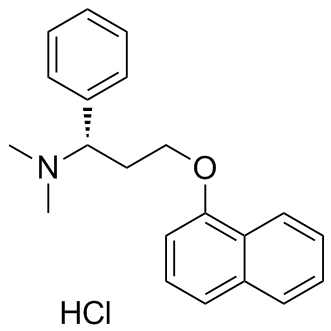
|
| DC1108 | Laninamivir (CS-8958) Featured |
Laninamivir (CS-8958) is a neuraminidase inhibitor which is being researched for the treatment and prophylaxis of Influenzavirus A and Influenzavirus B.
More description
|

|
| DC10389 | RIPA-56 Featured |
RIPA-56 is a highly potent, selective, and metabolically stable inhibitor of receptor-interacting protein 1 (RIP1) with an IC50 of 13 nM.
More description
|

|
| DC24077 | TY-52156 Featured |
TY-52156 is a potent and selective inhibitor of S1P3 receptor (Ki=110 nM).
More description
|
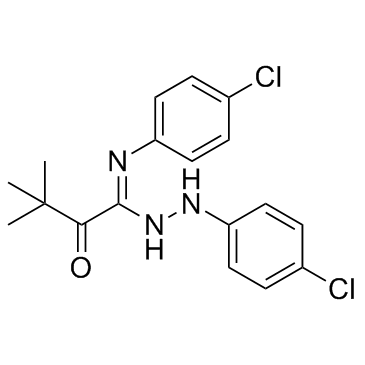
|
| DC34342 | HLM006474 Featured |
HLM006474 is a pan-E2F inhibitor. It inhibits DNA binding to E2F1, E2F2, and E2F4 in A375 melanoma cells when used at a concentration of 40 μM.
More description
|

|
| DC28414 | p-MPPI hydrochloride Featured |
p-MPPI hydrochloride is a selective 5-HT1A receptor antagonist with high affinity for 5-HT1A receptors. p-MPPI hydrochloride can crosses the blood-brain barrier, and has clear antidepressant and anxiolytic-like effects.
More description
|
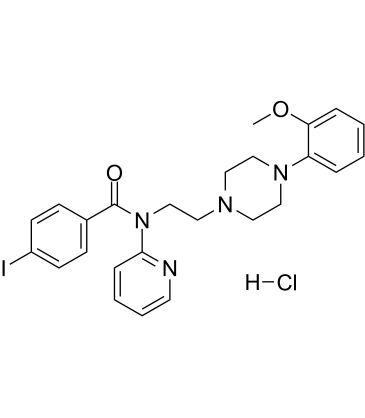
|
| DC33696 | Astemizole Featured |
Astemizole is a histamine H1-receptor antagonist. Astemizole competitively binds to histamine H1-receptor sites in the gastrointestinal tract, uterus, blood vessels, and bronchial muscle. This suppresses the formation of edema and pruritus caused by histamine. Astemizole is structurally similar to terfenadine and haloperidol; it has anticholinergic and antipruritic effects.
More description
|
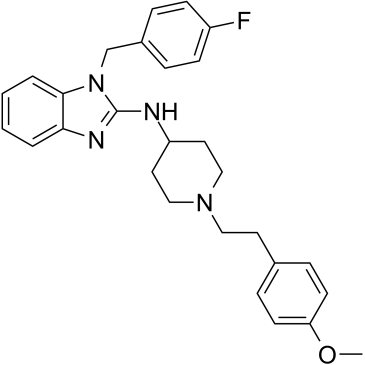
|
| DC5052 | Lersivirine(UK 453061) Featured |
Lersivirine (UK-453061) is a next-generation non-nucleoside reverse transcriptase inhibitor (NNRTI) under development for the treatment of HIV-1 infection.
More description
|
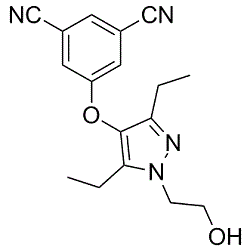
|
| DC22021 | BI 167107 Featured |
BI 167107 is a highly potent agonist of the β2 adrenergic receptor (β2AR) and β1AR (IC50=3.2 nM) and shows some activity as α1A antagonist (IC50 = 32 nM).
More description
|
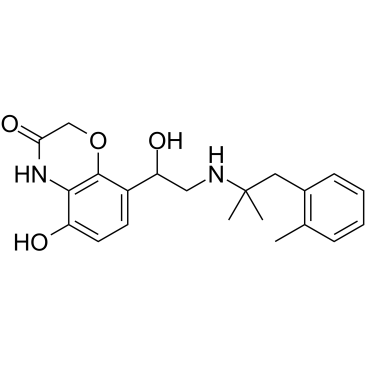
|
| DC10559 | Derazantinib (ARQ 087) Featured |
Derazantinib (Derazantinib) is an ATP competitive tyrosine kinase inhibitor; exhibits potent activity against FGFR1-3 chondrocytes with IC50s of 4.5, 1.8, and 4.5 nM, respectively.
More description
|

|
| DC10290 | PZM21 Featured |
PZM21 is a potent and selective μ opioid receptor agonist with an EC50 of 1.8 nM.
More description
|
|
| DC20714 | AZD-7594 Featured |
AZD-7594 (AZ-13189620) is a potent, nonsteroidal, selective glucocorticoid receptor modulator (SGRM) with binding IC50 of 0.9 nM, shows no affinity for AR, PR, MR and ERα/β.
More description
|
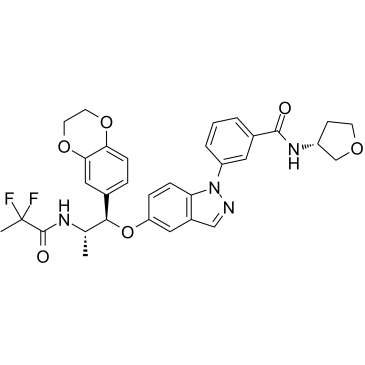
|
| DC10311 | Allopregnanolone Featured |
Allopregnanolone is a progesterone metabolite. Allopregnanolone is an allosteric modulator of the GABA receptor.
More description
|
|
| DCAPI1573 | Ipragliflozin (ASP1941) Featured |
Ipragliflozin (ASP1941) is a Novel Selective Sodium-Dependent Glucose Co-Transporter 2 Inhibitor, on Urinary Glucose Excretion in Healthy Subjects
More description
|

|
| DC10773 | AZD5069 Featured |
AZD-5069 is a potent and selective CXCR2 antagonist with the potential to inhibit neutrophil migration into the airways in patients with COPD.
More description
|

|
| DC10774 | AZD5153 Featured |
AZD5153 is a potent bivalent triazolopyridazine based Bromodomain and Extraterminal (BET) Inhibitor.
More description
|

|
| DC10561 | GSK-2018682 Featured |
GSK-2018682 is a sphingosine 1 phosphate receptor (S1PR)-1 agonist potentially for the treatment of multiple sclerosis.
More description
|

|
| DC7195 | JAK Inhibitor I(Merck 5, Pyridone 6) Featured |
Merck 5 is a potent and reversible ATP-competitive inhibitor of the JAK kinases (JAK1, JAK2, JAK3, and Tyk2). It also blocks IL2 and IL4 dependent proliferation of CTLL cells and inhibits the phosphorylation of STAT5.
More description
|
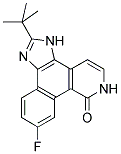
|
| DC24199 | OSU-T315 (ILK-IN-1) Featured |
OSU-T315 (ILK-IN-1) is a potent and specific integrin-linked kinase (ILK) inhibitor which inhibits PDK2 function in the AKT pathway activation
More description
|

|
| DC39251 | WKYMVm Featured |
WKYMVm is a selective agonist for the formyl peptide receptors FPR1, FPR2 (EC50 = 75 pM) and FPR3 (EC50 = 3 nM), expressed on immune cells. Induces Ca2+ mobilization and superoxide production in, and chemotaxic migration of, monocytes and neutrophils. Also promotes monocyte survival through a PKC-, PI 3-kinase- and Akt-dependent pathway.
More description
|

|
| DC39254 | DGAT1-IN-3 Featured |
DGAT1-IN-3 is a potent, selective and orally bioavailable inhibitor of DGAT-1, with IC50s of 38 nM for human DGAT-1 and 120 nM for rat DGAT-1. DGAT1-IN-3 could be used to research of obesity, dyslipidemia, and metabolic syndrome[1][2].
More description
|
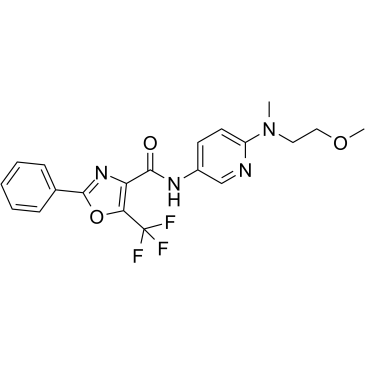
|
| DC23943 | K-7174 dihydrochloride Featured |
K-7174 dihydrochloride is a selctive small molecule inhibitor of the transcription factor GATA-binding protein 2 (GATA2).
More description
|
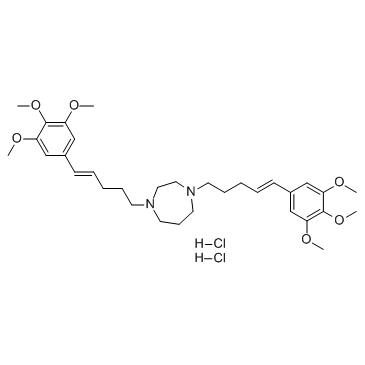
|
| DC11225 | sabizabulin(VERU-111) Featured |
VERU-111 (Sabizabulin) is a novel potent colchicine binding site inhibitor (CBSI) in tubulin with potential anticancer activities. Sabizabulin is a novel oral agent with both anti-viral and anti-inflammatory activities.Sabizabulin is a cytoskeleton disruptor which by causing microtubule depolymerization has both anti-viral and anti-inflammatory activity and could be effective against the SARS-CoV-2 virus by disrupting its intracellular transport along the microtubules. Microtubule trafficking is critical for viruses to be transported, replicated, assembled, and released from the cell. In addition, microtubule depolymerization drugs that target the “colchicine binding site” of microtubules, like sabizabulin, also have strong anti-inflammatory effects, including the potential to treat the cytokine release syndrome (cytokine storm) and septic shock induced by the SARS-CoV-2 viral infection that is associated with high COVID-19 mortality rates.
More description
|

|
| DC10217 | TRx0237 (LMTX) mesylate Featured |
TRx 0237 (LMTX™) mesylate is a second-generation tau protein aggregation inhibitor for the treatment of Alzheimer's disease (AD) and frontotemporal dementia.
More description
|

|
| DC11857 | BAY-8040 (R) Featured |
Bay-8040 is a potent, selective human neutrophil elastase (HNE) inhibitor with IC50 of 28 nM; displays no significant inhibition toward 68 other pharmacologically relevant targets (>10 uM), and a panel of related serine proteases; shows in vivo efficacy with regard to decreasing cardiac remodeling and amelioration of cardiac function in monocrotaline-induced rat model for pulmonary arterial hypertension.
More description
|

|
| DC28774 | CB-103 Featured |
CB-103 is a notch signaling pathway inhibitor extracted from patent US9296682B2. CB-103 is developed for the treatment of cancers.
More description
|

|
| DC11381 | Butabindide (oxalate) Featured |
Butabindide is a potent inhibitor of cholecystokinin-inactivating peptidase/tripeptidyl peptidase 2 (CCK-inactivating peptidase/TPP-2; Ki = 7 nM).1 It is selective for CCK-inactivating peptidase/TPP-2 over a panel of serine proteases (Kis = >1 μM) as well as CCK receptors (Kis = >0.1 mM).
More description
|
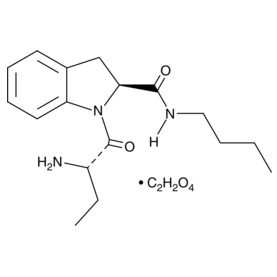
|
| DC39257 | FOXM1 Inhibitor III (FDI-6) Featured |
FDI-6 is an inhibitor of FOXM1. FDI-6 binds directly to FOXM1 protein, to displace FOXM1 from genomic targets in MCF-7 breast cancer cells, and induce concomitant transcriptional down-regulation.
More description
|
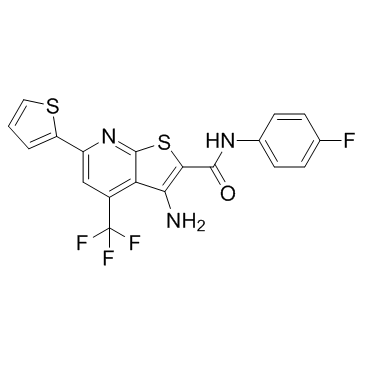
|
| DC11044 | Omidenepag Isopropyl Featured |
Omidenepag Isopropyl (DE-117, OMDI) is the prodrug of Omidenepag, which is a potent, selective agonist human EP2 receptor; demonstrates excellent IOP-lowering activities following ocular administration in ocular normotensive monkeys, Omidenepag Isopropyl (OMDI) is a clinical candidate for the treatment of glaucoma.
More description
|
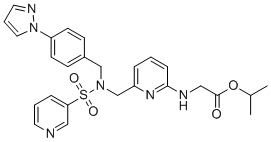
|
| DC20466 | MsbA inhibitor 1 Featured |
MsbA inhibitor 1 is a novel small molecule lipopolysaccharide biogenesis inhibitor, inhibits MsbA, an ATP-dependent flippase that translocates LPS across the inner membrane; causes mislocalization of LPS to the cell interior, inhibits Δ5 strain with MIC o
More description
|
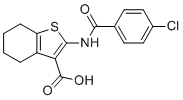
|